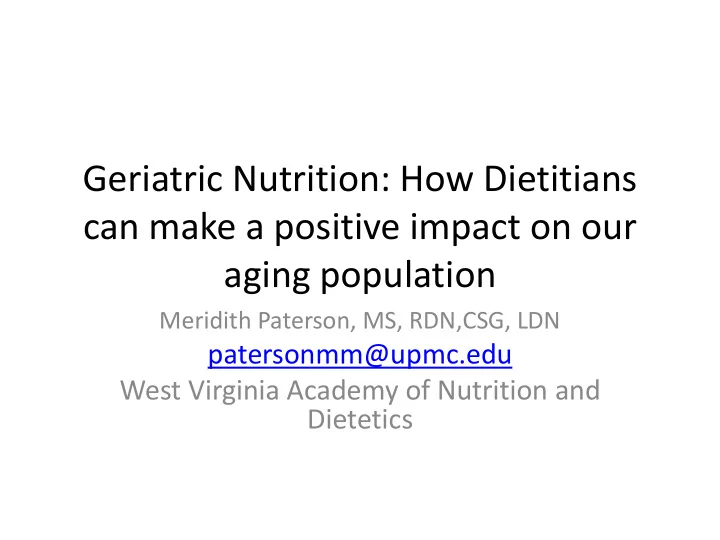

Geriatric Nutrition: How Dietitians can make a positive impact on our aging population Meridith Paterson, MS, RDN,CSG, LDN patersonmm@upmc.edu West Virginia Academy of Nutrition and Dietetics
Learning Objectives • Recognize the challenges of the aging population and the direct impact on nutrition outcomes. • Understand the role the dietitian in improving not only nutrition but quality of life as well. • Understanding the importance of learning each individual’s needs and wishes and not a one size fits all approach. • Learning Codes: 4190, 5100, 5430
Challenges of the aging population….
Aging Population • Between 2012 and 2050, the United States will experience considerable growth in its older population (65 years and older). • From 43.1 million (2012) to 83.7 million (2050) • Baby Boomers are a significant contributing factor to the increase in the older population. Ortman, Jennifer M., Victoria A. Velkoff, and Howard Hogan. An Aging Nation: The Older Population in the United States, Current Population Reports, P25-1140. U.S. Census Bureau, Washington, DC. 2014.
Challenges Facing the Elderly • Physical Changes • Cognitive Changes • Environmental Changes • Financial Changes
Physical Changes • Common changes noted: – Vision Impairment – Hearing Impairment – Taste Bud changes – Sense of smell – Sleep Disturbances – Oral Changes (tooth loss, dentures, implants) (May also have physical changes related to medical condition/ disease process)
Cognitive Changes • “Slowing down” • Forgetfulness • Memory may be effected related to dementia, depression, delirium and other medical conditions.
Oral Care • Approximately 25% of those 65 years and older have no natural teeth. • Diet and nutrition intervention for older adults with compromised oral integrity must target individual needs based on current diseases and disabilities. • Dietetics practitioners must address oral health as part of nutrition diet and screening, assessment, intervention, and monitoring of older adults. • Position of the Academy of Nutrition and Dietetics: Oral health and Nutrition. 2013;113(5).
Environmental Changes • No longer to be able to maintain their home • Moved to new environment (Apartment, move in with a family member, SNF, PCH) • May require giving up driver’s license • Giving up independent activities (cooking, shopping, going to church, etc.)
Financial Changes • May have went from two incomes to one income due to death of spouse or partner. • Income may not cover current expenses (utilities, food, medicine, car, etc.) • Increase cost of prescriptions
Direct impact on Nutrition • Food insecurity • Isolation • Depression • Chronic diseases • Dependent of others- decrease in independence • Oral hygiene (ill fitting dentures, mouth sores, thrush)
Other areas to consider • Education Level (Can they read?) • Evaluate the basics: Do they have a working kitchen that is accessible to them? Do they have support (family/ friend/ church) to help? Can they manage their finances?
The role of the Dietitian…
Role of the RDN • To look at the entire picture when it comes to nutrition • Think outside the box • Look at each person individually and nutrition plan should not be a one size fits all approach .
EOL Nutrition Issues
Dietitian's Role • Active role in educating and advocating for our patients. Dietitians are part of the palliative/ hospice team.
• The dietitian should talk with the patient and/or family member about wishes prior to a crisis. Be Proactive! • Schedule family meetings to discuss what the patient would want so that everyone is on the same page. • The goal is to provide an opportunity for patient to discuss his/ her wishes and to provide comfort and dignity at the end of life by honoring what they would want.
To Feed or Not to Feed? • Dietitian to educate patient and/or caregiver on palliative and/or EOL nutrition related issues and provide support. • Tube feedings, IV hydration, MBS studies • Issues surrounding feeding at the EOL. • The “waiver” to go against what is recommended- is this valuable to complete?
Dietitian’s Role • Liberalize diet ( this can be difficult for family members- diabetics) • Assess for constipation which may be related to pain medication, decrease mobility, inadequate fluid intake • Medications which may have negative effect (i.e. vitamins/ minerals may increase GI distress) recommend to discontinue any unnecessary medications
EOL Strategies • Offer comfort/ pleasure foods (encouraging family members to provide favorite foods) • Assess oral hygiene (for the demented patient cleaning their mouth before and after meals) • Offering smaller portions • Offering one food at a time • Monitoring for pain and constipation
Conclusion “To make a difference in someone’s life, you don’t have to be brilliant, rich, beautiful, or perfect. You just have to care.” Mandy Hale
Questions???
Recommend
More recommend